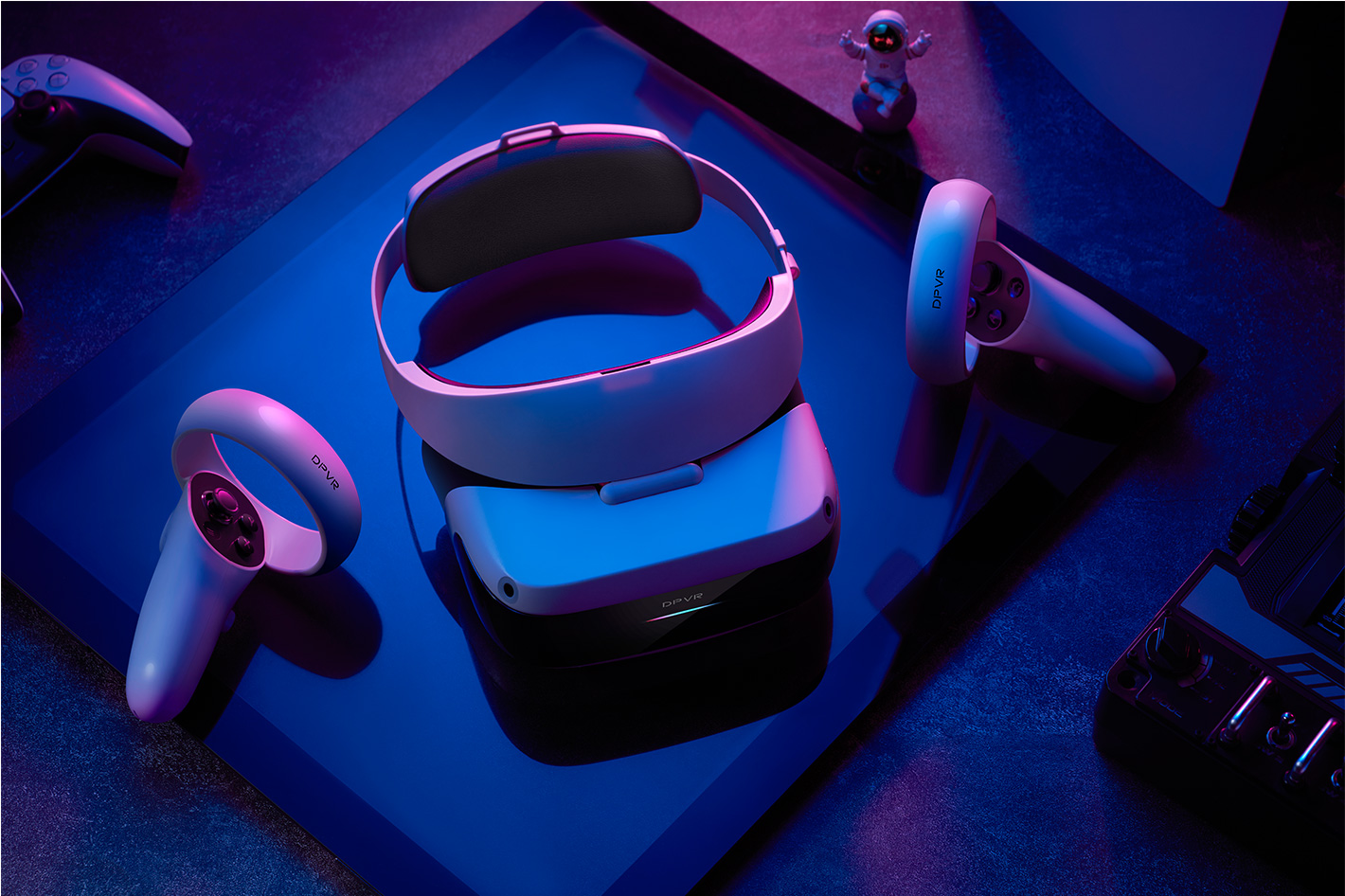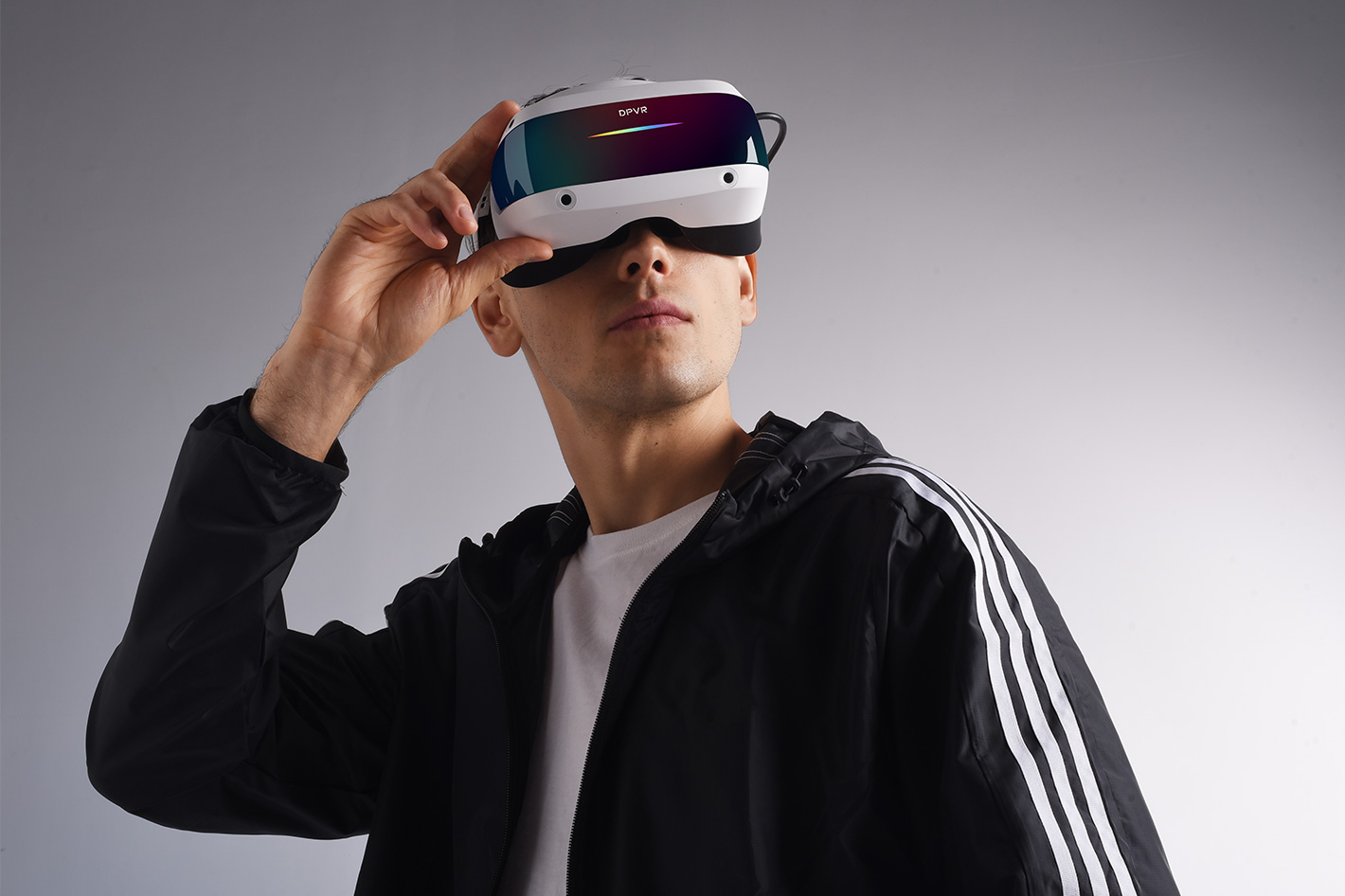
Let’s make it clear: the DPVR E4 VR headset is announced as designed for elite gamers, a claim that might help to sell units – if it really works – but that does not reveal the whole potential of a tethered VR headset, which can be used, if it is compatible, for anything from watching movies to Virtual Production. So, yes, having a new device coming to the market is a good thing, especially because PCVR headsets continue to offer the best quality in terms of image.
Introduced at VRDays, in Europe, the DPVR E4 VR headset appears at the same event where HP was present but without news of any new headset. Those expecting to see a Reverb G3 (maybe with pancake lenses…) materialize begin to believe that HP is, according to rumors, abandoning VR, which if true is a pity, because the Reverb G2 is a great headset only let down by a connection cable that continues to be the source of all problems. Even to get a replacement…
The HP Reverb G2 is, in fact, a premium VR headset for those who want quality more than ability of movement. While it also works for action games where you need to move a lot, for sitting down experiences, from flying and driving simulations to watching movies and VR experiences, it is the most popular and affordable solution. Those who prefer to jump around in games and don’t mind getting compressed video served to their eyes can use any of the non-tethered VR headsets available, which have their share of audience.


The world of VR is, in fact, divided between two types of VR headsets: the PCVR, which is tethered and offers the best quality but may be more difficult to use due to the cable hanging from the headset, and the standalone devices, which offer more freedom but generally less quality in terms of image. Unfortunately, the industry seems to trend towards the standalone headsets, which is, somehow, not helping to make VR shine, as only with a tethered device it is viable – for now – to explore the maximum quality of many VR apps. Some reviewers also seem biased when talking about PCVR, pointing to the connection cable as a negative aspect… I believe both have their public, as different tools for the same goal: being able to enjoy VR.
We’ve seen a few promises of PCVR headsets in recent years, but none have materialized, so this announcement by DPVR is interesting, at it suggests there is still interest for PCVR headsets. The DPVR E4 VR headset, announced as compatible with Steam – which is a key gaming platform – means there is a wide range of titles that can run on the device from DPVR, from games to most of the VR experiences that ProVideo Coalition has introduced to its readers in the last couple of years.
A PVCR headset coming from a Chinese company that claims it is a leading provider of virtual reality (VR) devices, makes people frown, so the announcement was met with suspicion. While DPVR is a name we may not be familiar in the West, the company was founded in 2015 and has acquired many VR technology patents. Its business covers B2B and B2C and DPVR claims it ha 300+ customers worldwide and provide them with customized VR headsets.
Before the announcement of the E4 VR headset, DPVR only focused on the B2B market and held a special space in the education and medical industries. In the past years, DPVR successively raised funds three times, obtained a large number of funds, and used them for technology development. Now, another piece of information I gathered from Canalys research, indicates that DPVR overtook HTC as the top VR headset vendor in China in Q2 2017 by shipping 18,000 headsets, a 30% quarter-on-quarter increase. HTC, whose only product is the HTC Vive basic headset, suffered a 6% sequential decline, shipping 14,000 units. Sony took third place, shipping 9,000 PlayStation VR headsets in the country. According to Canalys estimates, the overall VR headset market in China grew 25% quarter on quarter to reach 80,000 units.
Fast forward to 2022, and last March according to an IDC report, DPVR held the second place in the of the combined AR/VR market during 2021, behind Meta’s Quest 2, which has 78% share of the market. The reports notes that Pico VR products ranked third and HTC held the fifth position, and adds that Pico VR, like DPVR, is well positioned in Asian markets but has also done well in North America and Western Europe where it has helped fill the void left when Meta discontinued its Oculus Go. A clear sign that DPVR may, if it works, also conquer those markets with a product like the E4 VR headset.
So, DPVR is more popular than some believe, and its PC-tethered VR headset, which is DPVR’s first step into the consumer market, may be a welcome addition to a segment of the market that some suggest is dying. The only question that remains is: how good is this new device? The answer is not clear, and the information now available doesn’t help much, starting with a press-release that mentions a HDMI connection for the headset, when apparently, it’s a DisplayPort. It’s as if DPVR marketing and engineers did not talk much about the headset before sharing the information with the world.
DPVR claims that the E4 provides PC VR gamers with a tethered alternative that offers a wider field of view (FoV), in a more compact and lighter form factor, as well as offering a more affordable solution compared to high-price tag devices such as the VIVE Pro 2. While the FoV aspect may be true, some of the first “reviews” online point to problems with general quality, quality of lenses, setup, tracking, IPD adjustment, sound… and price.
The E4 offers a resolution of 3664×1920 pixels against the 2160×2160 per eye for the HP Reverb G2 (meaning the G2 has a total of 4320×2160 pixels), and the way the value is presented reflects the fact that the E4 only uses a single panel, while the Reverb G2 uses two. This may not be a problem in itself, but the fact that the E4 has no IPD adjustment, according to early reviewers, creates a problem for the headset. Meanwhile DPVR claims the E4 has automatic IPD adjustment between 54 and 74mm, which is somehow misleading, if there is nothing to adjust. It’s like saying a fixed focus lens as automatic adjustment of focus…
In the end, despite all the promises and suggestions, the DPVR E4 VR headset may not be the new standard for tethered VR headsets. Its cheap plastics, according to early reviews, mediocre tracking and comfort make it just another of those promises never accomplished that PCVR users have had to live with.
As it is for now, the HP Reverb G2, which was discounted for Black Friday in the USA, to a price as low as $300 – some people suspect HP is just cleaning the house before leaving their VR experience for good – continues to be the best PCVR headset, despite it still having a connection problem due to the bad quality of the cable, and the fact that Microsoft does not seem interested in Windows Mixed Reality any longer. Still, if you want a VR headset that offers maximum quality, there appears to be no competition from the newcomer from DPVR. HP Reverb G2, launched on November 2020, continues to be the best choice for PCVR two years after it was released. A real competitor is urgently needed, as there is no indication a HP Reverb G3 is planned.
An important foot note: I wrote this article when the official press-release from DPVR was available, but waited a few days to see the reactions to the launch of the new product. Well, there is practically none: a Google search gives about 34.000 results. Just for comparison, a search for the recent Pico 4, a standalone VR headset reaches 558,000,000 results, which does confirm the DPVR E4 VR headset is not attracting much attention. And when it does it’s mostly negative, a clear indication that this is not the PCVR headset the market wants. Who at DPVR believed this was the new standard for tethered VR headsets was wrong…

